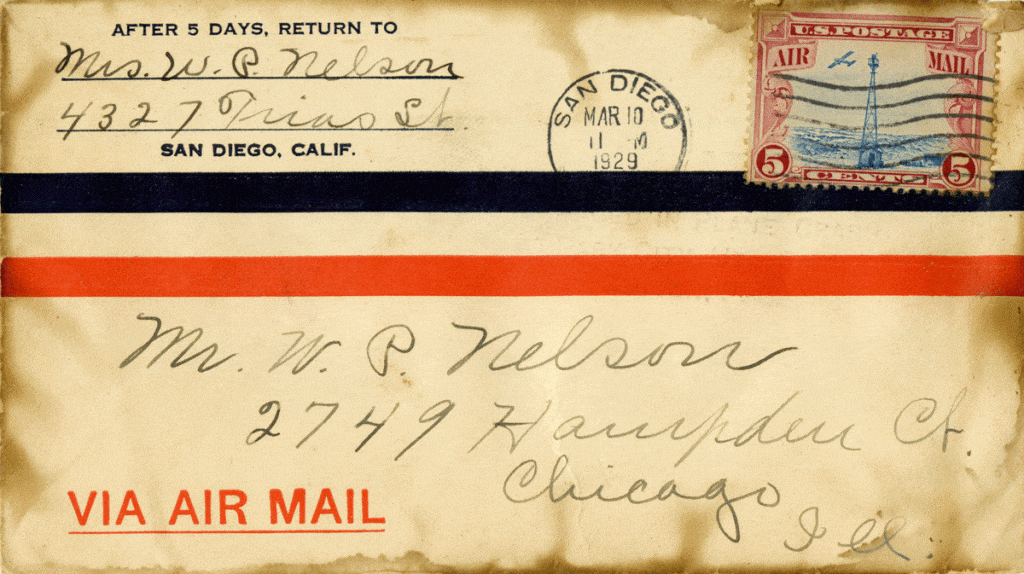Our story begins on Sunday morning March 10, 1929 in the Mission Hills District of San Diego, California when a Mrs. Emma Nelson mailed a letter to her husband in Chicago.
Mr. William Peter Nelson (WP to his family and friends) owned a successful construction company based in Chicago. The company, F.P. Nelson and Sons, was founded by his grandfather Florian Peter Nelson in the 1860s. During the winter months Mrs. Nelson preferred their residence in San Diego. Of course she missed her husband and wrote him frequently.
When mailing this letter on March 10, Mrs. Nelson did not hesitate to pay a premium for air mail delivery, though the cost was five cents versus two for first class mail. Little did she know that her letter would experience a “journey interrupted.”
By Monday afternoon, March 11, Emma’s letter arrived at the Salt Lake City airport, flown in by the Boeing Air Transport Company. The Boeing Aircraft Company had established this subsidiary in July 1927 to run Contract Airmail Route 18 from San Francisco to Chicago. The contract was administered by the United States Post Office Department.
In 1929 commercial aviation was considered risky business for mail and passengers alike. The primary aircraft on Route 18 was a Boeing Model 40A. It was the first Boeing plane designed to carry mail – up to 1000 pounds – and passengers with a maximum seating capacity of two. The passengers sat on wicker chairs in an enclosed compartment. The pilot was in an open cockpit. Navigation – night or day – was by Contact Flight Rules, known today as Visual Flight Rules, based upon human sight.
The plane was constructed primarily of spruce with a tubular steel frame. In the event of a crash, the wood became kindling with potentially deadly consequences. In 1929 there were fifty-one recorded airplane crashes killing sixty-one people. Using the same ratios, that would equate to 7,000 domestic airline-related deaths today. Fortunately the safety of air travel has improved significantly. Since February 2009 there have been no fatalities on any US carrier.
The plane carrying Emma Nelson’s letter departed Salt Lake at 6:00pm with forty-two sacks of mail and one passenger, Mr. K.A. Kennedy, a banking executive en route to Naples, Italy. Mr. R.T. Freng was piloting. Though he was the youngest pilot on Boeing’s roster, he was considered one of the best. He intended to refuel in Rawlins, Wyoming. The plane never made it.

Credit: Park City Historical Society and Museum
What does all of this have to do with Park City? Come back next week learn about the dramatic detour into our mountain town that Emma Nelson’s letter took and the heroic efforts of Parkites to save pilot, passenger, and post.
Also join us at the Park City Museum’s Education and Collections Center (2079 Sidewinder Dr.) at 5pm on Tuesday, March 13 to hear more about this story, the beginnings of air mail service, and the history of early aviation.